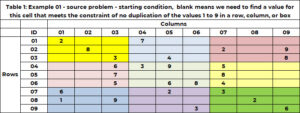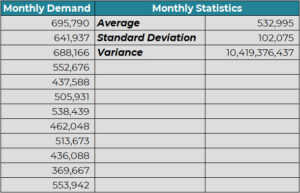Supply chain prognosticators, prophets and pundits frequently take out their crystal balls to chart what’s next for the intricate networks that move stuff around the globe. Once allowed to operate largely unbothered and under the radar, supply chains continue to be the “topic du jour” not only in boardrooms, but among the general public.
Credit the pandemic with raising the supply chain’s visibility, and not always in a positive way. The great toilet paper shortage of 2020, for example, was obviously the catalyst that impacted all of us. The constraints only accelerated from there, impacting everything from lumber to baby formula to chicken wings.
Fast-forward to 2024 and now the race is on to reveal “what’s coming next?” for the world’s supply chains. So following S&P Global Market Intelligence’s release of “The Big Picture: 2024 Supply Chain Industry Outlook,” I decided to take a deep dive into the report findings and provide some of my own context and opinions about the major trends covered in its pages.
What’s Really Driving the Supply Chain Narrative?
In its report, S&P Global covers some of the trends and opportunities that will “drive the supply chain narrative through 2024 and beyond.” It hits on topics like adapting to the new normal, paying for resilience in a high-cost environment and using tech and organizational agility to enable resilience.
At a high level, I agree with some of the company’s predictions and have my own opinion about others. Obviously, few would argue with the report’s underlying message that all companies need to be thinking about how to make their supply chains resilient. I completely agree with this.
The report then goes into the various ways companies have addressed resiliency and their relative successes and failures on this front. It also talks about the impact that geopolitical and environmental forces, and the aftermath of the pandemic, are having on supply chains.
While there’s no doubt that these three elements have been major sources of disruption in the last few years, the eternal reality is that there’s no such thing as a “steady state” supply chain. If it’s not one thing it’s another, so to speak, and this point could have been emphasized more in the report. As time marches on, these and other factors require a long-term investment in and focus on supply chain resiliency.
The problem is that many, if not most, companies are led by short-term goals. I’ve heard that companies in Japan can have a 100-year or longer mindset. But in the Western world, putting out daily fires often takes precedence over long-term plans. Some of it is a survival instinct; at other times it can result from chasing near-term profits. Even organizations with the best intentions to fortify supply chains have a hard time staying the course – as soon as the cost picture begins to tip, people start to make very different decisions. The report does acknowledge this concept, noting that in a high-cost environment, “reinvesting in capital stock may take priority over spending on supply chains,” but this also highlights the need for more focus on how immediate concerns, especially financial goals, often overshadow long-term strategic efforts in supply chain management and mitigation of supply chain risk.
Tackling the Generative AI Elephant
Right now, there’s no shortage of tech tools available to enable supply chain resilience, with generative artificial intelligence (AI) being the latest “life ring” to be tossed into the unpredictable supply chain waters. “While AI cannot prevent supply chain disruptions, if deployed in the correct manner it could provide predictive probabilities of future disruptions,” S&P Global points out in its report.
The report does note that, like most advanced technologies, generative AI still needs some time to mature and find its true place in the scheme of supply chain management. Generative AI could allow us to expand the reach of simulation and optimization technologies so that they can be called upon by a less technical person, because generative AI can quickly and effectively learn from research and data that has already been published and bring existing answers forward. However, I have not seen much about how it will create better or different solutions. Whether you’re doing scenario planning, asking what-if questions or using it for another purpose, generative AI itself isn’t going to do the math in the background to answer the questions for you. So, in my mind, the impact of this technology is making the solutions more accessible, not necessarily newer, better solutions. A mistake in the past that the tech field has been prone to is viewing the latest shiny object as a silver bullet. While I agree that generative AI and other tools are helpful and can make supply chain planning better, faster or less cumbersome, I wouldn’t oversell them as the be-all and end-all that will anticipate the future to allow planners to mitigate supply chain risks.
Addressing the Nationalism Movement
It’s not a big secret that—similar to the increased focus on environmental, social and governmental (ESG) issues—we’re seeing a long-term trend of nationalism, or the prioritizing of a nation’s own economy and interests over those of other countries. In certain areas, this has already started manifesting into trade protectionism, government subsidies for domestic companies and mandating that certain product components must be sourced or manufactured domestically.
The report mentions the reshoring trend, the conflicts in Ukraine and the Middle East, and migration at the U.S.-Mexico border as some of the key potential disruptors for supply chains now and going forward. S&P Global says geographic diversification is one route to better supply chain resilience and a shield against disruptions to “sourcing, transportation and optionality.” While this makes sense, it is important to note that the last 20-plus years have been different. The world has come to rely on a lot of supplies from distant sources, often in Asia. The low costs were the main driver, and the source was stable and lead times were predictable, which made it all work. But that is now being questioned.
From my viewpoint, nationalism is going to have a long-term impact on how supply chains are positioned. For example, few people thought twice about having products made elsewhere and imported to the U.S. 20 years ago. However, as immigration and other debates continue to receive attention from global politicians, some degree of localization will be driven by nationalistic tendencies. This could have the impact of taking otherwise reliable supply points out of the picture as they grapple with the nationalistic edicts of their respective governments.
Mitigating Supply Chain Risk in an Unknown and Uncertain Future
In general, I agree with most of what S&P Global published in this report, with just a few exceptions or nuances. As a supply chain practitioner, I agree that resiliency is critical for the world’s supply chains to continue growing, thriving and surviving.
In essence, supply chain planning rests on the future, and the future is inherently uncertain. Companies must be prepared for whatever supply chains throw at them, and that requires a high dose of resilience. When it comes to investing in efforts to fortify and mitigate supply chain risks, that means getting out of the “next quarter” mindset and adopting a 10-15 year thought process. The bottom line is that the future will always bring whatever the heck it brings, so you can’t—even with the help of an advanced tool like generative AI—whip up a nice software program and hope it will turn you into Nostradamus. Unfortunately, it just doesn’t work that way.
Feeling uncertain about the resilience of your supply chain planning? We can help.
- SEO Powered Content & PR Distribution. Get Amplified Today.
- PlatoData.Network Vertical Generative Ai. Empower Yourself. Access Here.
- PlatoAiStream. Web3 Intelligence. Knowledge Amplified. Access Here.
- PlatoESG. Carbon, CleanTech, Energy, Environment, Solar, Waste Management. Access Here.
- PlatoHealth. Biotech and Clinical Trials Intelligence. Access Here.
- Source: https://blog.arkieva.com/unpacking-sp-global-2024-supply-chain-industry-outlook/?utm_source=rss&utm_medium=rss&utm_campaign=unpacking-sp-global-2024-supply-chain-industry-outlook
- :has
- :is
- :not
- ][p
- $UP
- 20
- 20 years
- 2020
- 2024
- a
- About
- accelerated
- accessible
- acknowledge
- adapting
- addressed
- Adopting
- advanced
- aftermath
- against
- ago
- agree
- AI
- All
- allow
- allowed
- already
- also
- always
- among
- an
- and
- Another
- answer
- answers
- anticipate
- ARE
- areas
- argue
- around
- artificial
- artificial intelligence
- Artificial intelligence (AI)
- AS
- asia
- asking
- At
- attention
- available
- Baby
- background
- BE
- be-all
- because
- been
- begins
- being
- BEST
- Better
- Beyond
- Big
- Big Picture
- border
- Bottom
- bring
- Brings
- but
- by
- called
- CAN
- cannot
- capital
- Catalyst
- certain
- chain
- chains
- Chart
- come
- comes
- coming
- Companies
- Company’s
- completely
- components
- concept
- Concerns
- conflicts
- constraints
- context
- continue
- correct
- Cost
- Costs
- could
- countries
- course
- covered
- covers
- create
- critical
- Crystal
- cumbersome
- daily
- data
- debates
- decided
- decisions
- deep
- deep dive
- Degree
- deployed
- different
- Disruption
- disruptions
- Disruptors
- Distant
- dive
- diversification
- do
- does
- Doesn’t
- doing
- Domestic
- domestically
- dose
- doubt
- driven
- driver
- driving
- East
- economy
- effectively
- efforts
- elements
- elsewhere
- emphasized
- enable
- Environment
- environmental
- ESG
- especially
- essence
- Even
- everything
- example
- existing
- Expand
- factors
- failures
- faster
- few
- field
- financial
- financial goals
- Find
- findings
- fires
- Focus
- following
- For
- Forces
- formula
- fortify
- Forward
- frequently
- from
- front
- future
- General
- general public
- generative
- Generative AI
- geographic
- geopolitical
- getting
- Global
- global market
- globe
- Goals
- Goes
- going
- Government
- governmental
- Governments
- great
- Growing
- Hard
- Have
- having
- heard
- help
- helpful
- High
- highlights
- Hits
- hope
- How
- How To
- However
- HTTPS
- i
- if
- immediate
- immigration
- Impact
- impacted
- impacting
- important
- in
- increased
- industry
- inherently
- Intelligence
- intentions
- interests
- into
- intricate
- investing
- investment
- IT
- ITS
- itself
- Japan
- just
- Key
- largely
- Last
- latest
- lead
- LEARN
- Led
- less
- Level
- like
- Line
- Localization
- long-term
- longer
- Lot
- Low
- made
- Main
- major
- make
- MAKES
- Making
- management
- mandating
- manner
- manufactured
- many
- Market
- math
- mature
- max-width
- May..
- means
- mentions
- message
- Middle
- Middle East
- migration
- mind
- Mindset
- mistake
- Mitigate
- mitigation
- more
- most
- move
- much
- must
- my
- NARRATIVE
- Nations
- necessarily
- Need
- needs
- networks
- New
- newer
- next
- nice
- no
- normal
- note
- noting
- now
- nuances
- object
- of
- often
- on
- once
- ONE
- only
- operate
- Opinion
- Opinions
- opportunities
- optimization
- or
- organizational
- organizations
- Other
- Others
- otherwise
- out
- Outlook
- over
- own
- pages
- pandemic
- Paper
- past
- paying
- People
- person
- picture
- Place
- planning
- plans
- plato
- Plato Data Intelligence
- PlatoData
- Point
- points
- Politicians
- positioned
- positive
- potential
- precedence
- Predictable
- Predictions
- predictive
- prepared
- prevent
- prioritizing
- priority
- probabilities
- Problem
- process
- Product
- Products
- profits
- Program
- provide
- public
- published
- purpose
- Putting
- Questioned
- Questions
- quickly
- Race
- radar
- raising
- reach
- Reality
- really
- receive
- relative
- release
- reliable
- rely
- report
- require
- requires
- research
- resilience
- resilient
- respective
- result
- reveal
- Risk
- risks
- Route
- s
- S&P
- S&P Global
- says
- scenario
- scheme
- Secret
- seeing
- seen
- sense
- Shield
- short-term
- shortage
- Silver
- simulation
- So
- Social
- Software
- Solutions
- some
- Soon
- Source
- sourced
- Sources
- speak
- Spending
- stable
- start
- started
- staying
- Still
- stock
- Strategic
- stuff
- successes
- such
- supplies
- supply
- supply chain
- supply chain management
- Supply Chain Planning
- Supply Chain Resilience
- Supply chains
- survival
- Take
- takes
- taking
- Talks
- tech
- Technical
- Technologies
- Technology
- tendencies
- that
- The
- The Future
- The Source
- the world
- their
- Them
- then
- There.
- These
- they
- thing
- Thinking
- this
- those
- thought
- three
- thriving
- Through
- throw
- time
- times
- tip
- to
- Toilet
- tool
- tools
- Topics
- tossed
- trade
- transportation
- Trend
- Trends
- true
- TURN
- Twice
- u.s.
- Ukraine
- Uncertain
- under
- underlying
- unfortunately
- unknown
- Unpacking
- unpredictable
- upon
- us
- using
- various
- very
- viewing
- viewpoint
- visibility
- was
- Waters
- Way..
- ways
- we
- were
- Western
- Western World
- What
- whatever
- when
- whether
- which
- while
- will
- wings
- with
- Work
- world
- world’s
- would
- year
- years
- you
- Your
- zephyrnet













